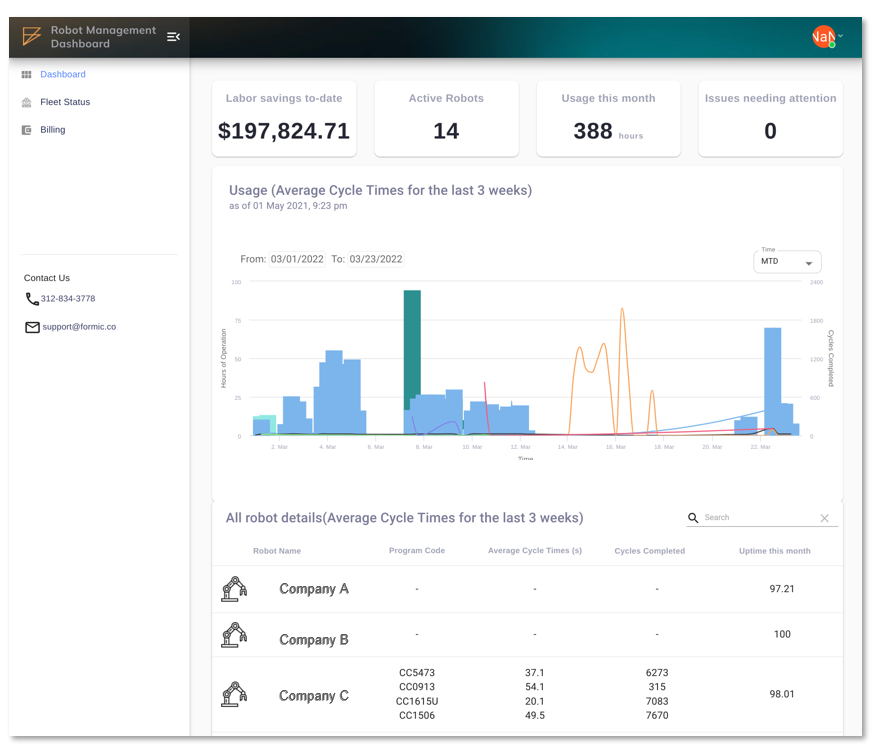If you’ve ever had your car break down, you know the frustration of suddenly broken equipment. Regardless of whether you were driving to the emergency room or on a casual trip to the grocery store, it is stressful at best and maybe life-altering in the worst scenarios.
Equipment downtime in manufacturing does not carry the same life-changing effects, but it does carry significant financial effects. According to IIoT World and Aberdeen Research, equipment failure in the general manufacturing sector costs up to $260k per failure, and this cost is much higher in automotive industries.
But how often does robotic automation downtime occur?
According to the International Journal of Performability Engineering, robot system failure occurs approximately 12% of the year on average. This number may seem high, but it can easily be reduced to single digits. In fact, the robot is rarely the issue. Some FANUC and ABB robots are now reaching 100,000 hours of Mean Time Between Failure (MTBF). So what is really going on and how are manufacturers managing their robot cells?
The Traditional Way
For several decades, some equipment OEMs and integrators have offered maintenance contracts to manufacturers, and this is still common today. The philosophy is that failure is inevitable, so service technicians and tools are armed and ready to troubleshoot, support, and replace parts as needed.
In addition to fast and reliable support, there are recommended practices for preventative maintenance. Just as we have annual physician “check ups” for our health, industrial equipment has recommended “check ups” and calibration cycles. Sometimes these events are routinely scheduled and based on time (i.e. each month or quarter). Other times, maintenance events are dynamically determined by data (temperature, performance drift, sensor input, etc.).
As the industry has advanced, we have seen progression towards more data-based approaches, which further optimizes uptime and lowers costs.
IoT Enters the Scene
Internet of Things (IoT), or specifically Industrial IoT (IIoT), has been booming for the last decade and is still in early innings. For managing industrial equipment, there are several benefits, but in terms of maintenance, this enables the additional benefit of predictive maintenance (“Pdm”).
Predictive maintenance is the act of using data, typically across fleets of internet-connected equipment, to proactively predict when equipment will fail, prior to the event happening. It is a proactive approach, but what separates it from preventative maintenance (which is also proactive) is that it is more automated or “hands off”. When predictive maintenance models work correctly, you don’t need to manually run tests every month. You only run them when the computer model suggests that you should.
The ultimate benefit of Predictive Maintenance is it results in healthier equipment and lower costs. PWC’s Predictive Maintenance 4.0 report from 2018 revealed that Pdm methods can improve uptime by up to 9% and increase lifetime of ageing equipment by 20%.
What Solutions Exist for Robot Maintenance?
The traditional model continues. If you invest in robotic automation for your factory, you will typically be offered a service contract. You will often receive equipment training and recommended maintenance plans also. Fortunately, many OEMs and integrators also offer some level of remote diagnostics, too, which expedites the troubleshooting process.
Above and beyond those standard offerings, capabilities highly differ and the more advanced IoT offerings become less common. Here are some examples of what might be available to you, depending on your equipment and integrator:
- Fanuc “Zero Down Time” (ZDT) - Fanuc’s internet-based preventive and diagnosis platform. By connecting your robot to ZDT and the centralized management system of Mechanical Condition Check, Process Status Check, Preventive Maintenance, and System Health Check, you can achieve a higher uptime ratio.
- IoT Platforms - Brand-agnostic IIoT platforms also exist. For example, Machine Metrics and Makina Rocks are examples of industrial technology suppliers that provide modular platforms to monitor equipment, run AI/ML algorithms to detect anomalies, and aggregate everything into a central cloud-based User Interface (UI) or dashboard.
- Formic Edge Analytics - Formic has an IIoT solution too! Because of our RaaS model and “pay for performance” only, we monitor robot uptime data. However, that is only a basic necessity to operationalize and ensure our service contracts. More importantly, we also have developed software tools to monitor your equipment. As shown below, Formic customers can see their fleet of robots, the production usage and invoices, and real-time data from the equipment. The main benefits is that it provides insights into your operations, and Formic can provide better, pro-active support. In fact, check out the testimonial from Georgia Nut Company to see the proof in the real world.

Figure 1 - Formic User Dashboard
A Big Boost in Confidence - The Robot is Rarely the Weakest Link
For those who are considering robotic automation for the first time, one important point is that the failure rate of the robot is probably better than some of your current equipment. As mentioned above, FANUC robots have Mean-Time-Between-Failure (MTBF) specifications that range from 40,000 hours to 100,000 hours. That means the robot itself could operate for more than 11 years without failing!
According to the International Journal of Performability Engineering and a survey of 400 factory owners, 80% of failures are not related to the robot. (See the Figure, below). And if there is a robot failure, almost half of that time is due to positioning issues, which is probably because someone or something crashed into the robot or sensor.

Figure 2 - The Causes of Robot Cell Downtime
The Bottom Line
The three major takeaways:
- Equipment failure is inevitable, but the issue is rarely the robot.
- With proper maintenance plans, tools, and support, failure rates can be reduced to single-digit percentages.
- Reliable products, service, and support are the basic foundation, but new proactive IIoT approaches can minimize costs by boosting uptime by ~9%
Overall, there is an overwhelming business case for robotic automation and increased predictability in manufacturing. The alternative of trying to find and hire someone to do the dangerous or dull tasks continues to be almost impossible.
But like anything else, automation equipment needs proper attention and maintenance. Luckily, that job is shifting away from the manufacturer and more towards companies like Formic. This is one of the beauties of our full-service automation.
-
Formic combines the best of robotics, financing, maintenance, and support - all in one place, for one low hourly rate. Interested in learning more?
Contact us today to set up a free consultation and explore opportunities to work together.


